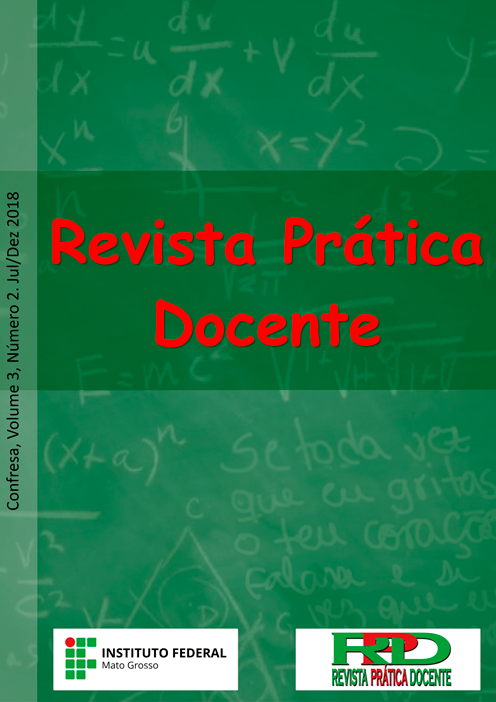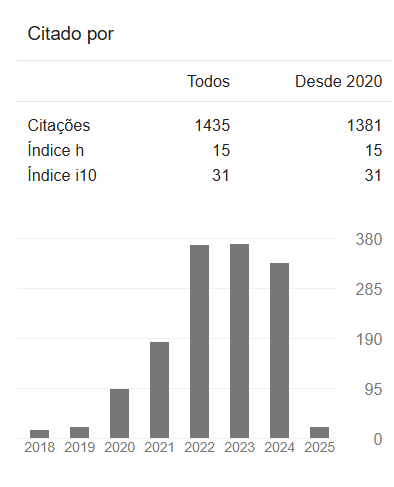INFORMATION AND COMMUNICATION TECHNOLOGIES AND ACTIVE METHODOLOGIES: ELEMENTS FOR TEACHING WORK IN HIGHER EDUCATION
DOI:
10.23926/RPD.2526-2149.2018.v3.n2.p798-812.id281Keywords:
Digital Information and Communication Technologies, Nursing education, Teaching Work, Teacher trainingAbstract
The use of Digital Information and Communication Technologies TDICs and the active methodologies in the university space point to a new way of establishing the work and role of teachers and students in the process of teaching learning. In this sense, this research aimed to understand the perception of teachers of the Nursing course on the use of TDICs as mediators of learning. It is a qualitative research carried out through a bibliographical survey and case study with 6 teachers of the Nursing course of a Private University of the State of Goiás. The incorporation of technological tools tends to a more enriching pedagogical practice, interaction and integration as well as the ability to understand the knowledge, by teachers and students. In the Nursing area, great efforts have been made to extract greater benefits from the use of the TDICs to obtain and / or guarantee a higher degree of quality in the Teaching. Given this, it was possible to point out that nursing education mediated by the use of TDICs is a challenge requiring students, teachers and institutions of higher education changes in the posture in front of the educational process.
Downloads
Metrics
References
BACICH, Lilian.; MORAN, José. Aprender e ensinar com foco na educação híbrida. In: Revista Pátio, nº25, p.45-47. São Paulo: ECA/USP, 2015. Disponível em: < http://www2.eca.usp.br/moran/wp-content/uploads/2015/07/hibrida.pdf > Acesso em: 13 jun. 2018.
BACICH, Lilian.; MORAN, José. Metodologias Ativas para uma Educação Inovadora: Uma abordagem teórico-prática. Porto Alegre: Penso, 2018.
BARDIN, Laurence. Análise de conteúdo (3ª ed.). Lisboa, Portugal: Edições 70, 223p. 2004.
BARTOLOMÉ, Antonio.Ramón. Nuevas tecnologías em el aula. Barcelona: Grão, 1999
BEHRENS, Marilda Aparecida. O paradigma emergente e a prática pedagógica. Curitiba: Champagnat, 1999.
Brasil. RESOLUÇÃO CNE/CES Nº 3, DE 7 DE NOVEMBRO DE 2001. Institui Diretrizes Curriculares Nacionais do Curso de Graduação em Enfermagem. Disponível em: http://portal.mec.gov.br/cne/arquivos/pdf/CES03.pdf
BUCKINGHAM, David. Cultura digital, educação midiática e o lugar da escolarização. Educação e Realidade, Porto Alegre, v. 35, n. 3, p. 37-58, 2010. Disponível em: http://seer.ufrgs.br/educacaoerealidade/article/view/13077/10270 . Acesso em: 12 out. 2018.
CARVALHO, Adriano. Almeida de. KLS 2.0: uma ferramenta disruptiva de ensino. Dissertação de Mestrado em Ensino. Universidade de Cuiabá. 2018. DOI: https://doi.org/10.17921/2447-8733.2018v19n2p177-180
COSCARELLI, Carla. Viana; RIBEIRO, Ana Elisa (Orgs). Letramento digital: aspectos sociais e possibilidades pedagógicas. 2. ed. Belo Horizonte: Ceale; autêntica, 2007
FRANÇA, Cintia. Simioni.; BATTINI, Okçana. Formação de professores e politicas publicas educacionais: qual a função das tecnologias de informação e comunicação no espaço escolar? ÁGORA, Porto Alegre, Ano 6, jul/dez.2015.
KENSKI, Vani. Moreira. Tecnologias e ensino presencial e a distância. Campinas: Papirus, 2003.
KLEIMAN, Ângela . Os significados do letramento. Campinas, S.P.: Mercado de Letras, 1995.
LEVY. P. Pierre. Cibercultura. São Paulo: Editora, 2008.
LIBÂNEO, José. Carlos. Prefácio. In: GUIMARÃES, V.S. Formação de Professores: saberes, identidade e profissão. 5ª ed. Campinas/SP: Papirus, 2010.
LOPES, M. V. O.; SILVA, V. M.; ARAÚJO, T. L. Observation mediated by computer - professional report. Online Braz J Nurs, 2006; 5(2). DOI: https://doi.org/10.5935/1676-4285.20060296
MARTINELLI, Maria Lúcia (org): Pesquisa Qualitativa: um instigante desafio. São Paulo, Veras Editora, 1999.
MORAN, José., MASETTO, Marcos. Tarcisio. & BEHRENS, Marilda. Aparecida. Novas tecnologias e mediação pedagógica. Campinas, SP: Papirus. 2000.
NÓVOA, Antonio. Professores imagens do futuro presente. Lisboa: Educa, 2009. Disponível: http://www.slideshare.net/mzylb/antonio-novoa-novo-livro
PACHECO, Samuel Bueno. 1997. Internet: As relações de ensino-aprendizagem no hiperespaço. Tecnologia Educacional. v.25, n.136, 137, mai/jun/jul/ago.1997.
PERRENOUD, Phelip. A prática reflexiva no ofício de professor: profissionalização e razão pedagógica. Porto Alegre: Artmed, 2002.
REIS, Maria. Aparecida; NANTES, Eliza Adriana. Sheuer; MACIEL, Cilene, Maria. Lima. Antunes: Letramento digital: uma investigação da teoria à prática docente de professores do estado de Mato Grosso. Instituto Federal de Mato Grosso - Campus Confresa Revista Prática Docente. v. 3, n. 1, p. 249-262, jan/jun 2018. DOI: https://doi.org/10.23926/RPD.2526-2149.2018.v3.n1.p249-262.id88
ROJO, Roxane; ALMEIDA, Eduardo de Moura. Multiletramentos na escola. São Paulo: Parábola Editora, 2012.
ROJO, Roxane; ALMEIDA, Eduardo de Moura. Letramentos múltiplos, escola e inclusão social. São Paulo: Parábola, 2009
SCHEFFER Silva. da Schell, Ana. Paula, RUBIM Pedro., EVA Néri., Autonomia no processo de construção do conhecimento de alunos de enfermagem: o chat educacional como ferramenta de ensino. Revista Latino-Americana de Enfermagem [en linea] 2010, 18 (Abril-Sin mes) : [Fecha de consulta: 13 de octubre de 2018] Disponible en:<http://www.redalyc.org/articulo.oa?id=281421932011>
SCHÖN, Donald. A. Formar professores como profissionais reflexivos. In: NÓVOA, António (Coord). Os professores e a sua formação. 2. ed. Lisboa: Dom Quixote, 1995.
SCHWAB, Klaus. A quarta revolução industrial. Disponível em: https://webcache.googleusercontent.com/search?q=cache:65nG8zZQNcsJ:https://edisciplinas.usp.br/pluginfile.php/4212041/mod_folder/content/0/Schwab%2520%25282016%2529%2520A%2520quarta%2520revolucao%2520industrial.pdf%3Fforcedownload%3D1+&cd=2&hl=pt-BR&ct=clnk&gl=br Acesso em 10/10/2018
SOARES, Magda. Letramento: um tema em três gêneros. 3 ed. Belo Horizonte: Autêntica, 2009.
TANAKA, Raquel Yurika et al . Objeto educacional digital: avaliação da ferramenta para prática de ensino em enfermagem. Acta paul. enferm., São Paulo , v. 23, n. 5, p. 603-607, Oct. 2010 . Available from <http://www.scielo.br/scielo.php?script=sci_arttext&pid=S0103-1002010000500003&lng=en&nrm=iso>. access on 11 Nov. 2018. http://dx.doi.org/10.1590/S0103-21002010000500003. DOI: https://doi.org/10.1590/S0103-21002010000500003
TAVARES Izaildo.; COSTA Patricia; OLIVEIJO T, F. Hipermídias para o ensino de enfermagem em ambiente digital de aprendizagem. CIET: EnPED, S.l.], maio 2018. ISSN 2316-8722. Disponível em: <http://cietenped.ufscar.br/submissao/index.php/2018/article/view/207>. Acesso em: 15 jul. 2018.
VALENTE, José. Armando., “A Telepresença na Formação de Professores da Área de Informática em Educação: Implantando o Construcionismo Contextualizado”. Actas do IV Congresso Ibero-Americano de Informática na Educação – RIBIE98, Brasília, CD-Rom, /trabalhos/232.pdt, 1998
Downloads
Published
How to Cite
Issue
Section
License
Copyright (c) 2023 A Revista Prática Docente tem o direito de primeira publicação

This work is licensed under a Creative Commons Attribution-NonCommercial 4.0 International License.
Authors who publish in this journal agree to the following terms:
- Authors retain the copyright and grant the journal the right of first publication, with the paper simultaneously licensed under the Licença Creative Commons Attribution allows the sharing of the work with acknowledgment of authorship and initial publication in this journal.
- Authors are authorized to take additional contracts separately, for non-exclusive distribution of the version of the work published in this journal (e.g. publish in institutional repository or as a book chapter), with acknowledgment of authorship and initial publication in this journal.











